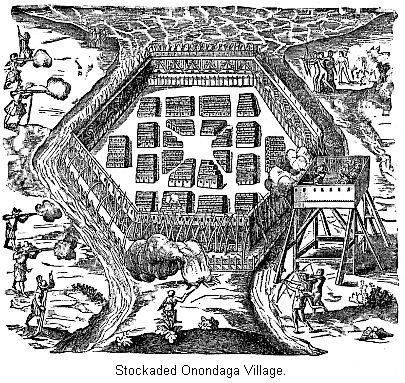The Onondaga Indian Tribe is one of the five tribes that were part of the Iroquois Confederacy. This confederacy also included the Mohawk, Cayuga, Oneida, and Seneca Indian tribes.
The Onondaga became a central location for the Confederacy as it was located in the middle. Many of the most powerful leaders of the tribe would meet in the capital of the Onondaga Indian tribe to discuss important issues. This led to the Onondaga tribe being named "The Keepers of the Fire."
History
According to oral tradition, The Great Peacemaker approached the Onondaga and other tribes to found the Iroquois Confederacy. At the time, the Senaca tribe was still in debate as to whether or not they were going to join the Confederacy. The oral tradition says that a solar eclipse took place (which can be approximately dated at 1142 AD) and was visible to the Seneca tribe. This would lead to the Seneca joining the Confederacy.
The Iroquois Confederacy became the most powerful force among the Northeast Indian Tribes, which would lead to many tribes surrounding them becoming their enemies and looking for a way to shift the balance of power.

The French explorer Samuel de Champlain had plans to colonize New France, which was north of the Confederacy. In order to do that, he needed to keep the goodwill of his native allies, which made the fur trade a lucrative endeavor. Among those tribes was the Huron tribe, who were enemies of the Iroquois.
A planned raid on an Onondaga village was planned between the Huron and Champlain's men. The raid did not go as planned due to the Huron being undisciplined. Champlain and his men constructed a wooded tower to perch themselves above the village and bring musket fire down onto the village while the Huron slowly advanced under the cover of wooden shields.
The Huron had not been trained in this sort of warfare that required discipline and broke their ranks and charged the village. The Onondaga warriors easily stopped their advance and sent the Huron in retreat. They then shifted their focus to the Frenchmen above and managed to push them into a retreat when Champlain took an arrow to his leg.
The Huron and Champlain retreated, and Champlain did not return again.
American Revolution
The event that changed the landscape for most Native Americans was the American Revolution.
When the Revolutionary War began, the Onondaga, along with the other Iroquois, took a neutral stance. However, that stance would change as the war would drag on. The Mohawk leader Joseph Brant had visions of an independent Native American nation and became an ally to the British, and most of the Iroquois followed. The exception was the Oneida tribe, who shared a border with the colonists and had friendly relations with many of them.
After the defeat of the British, many of the Onondaga followed Joseph Brant to Upper Canada, where they received land from the British Crown.
On November 11, 1794, the Onondaga Nation, along with the other Iroquois, signed the Treaty of Canandaigua with the United States, in which their right to their homeland was acknowledged by the United States in Article II of the treaty.
In 1816, 450 Onondaga were living in New York, 210 of whom lived on the Buffalo Creek Reservation.
Culture
Prestige: Among the Iroquois, the Onondaga was the most revered. They were known as the "Fire-keepers" of the Confederacy and, because of their central location, hosted most of the meetings between the tribes. They were keepers of the law in order to preserve traditions and institutions. The title of Thadodaho was always held by an Onondaga chief. He was to be the chief arbitrator of the Lords of the Confederacy.
Activities: The Onondaga was known to enjoy sports. Some of their favorite activities were Lacrosse, foot races, mumble the peg, marbles, games of ball, pull away, and fox and geese.
Ceremonial Traditions: The Onondaga Indian Tribe practiced the spreading of ashes when taking care of the sick, and their funerals were quiet affairs with their women covering their faces. There were also special events such as the Planting Feast, which would happen in May or when the Onondaga believed the ground was ready. This was three days for penitential and religious services. One day for the children's dance, and one each for the Four Persons, the Holder for the Heavens, the Thunder, and for gambling.
Government: The Onondaga was similar to many of the natives in that area. The chiefs were nominated by the clan mothers rather than elected.
